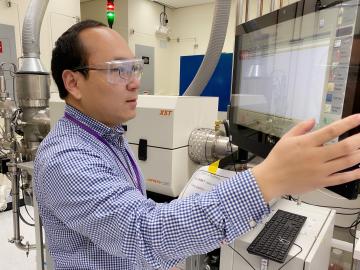
Filter News
Area of Research
- (-) Materials (22)
- (-) Neutron Science (14)
- (-) Supercomputing (31)
- Advanced Manufacturing (3)
- Biological Systems (1)
- Biology and Environment (21)
- Computational Biology (1)
- Electricity and Smart Grid (1)
- Energy Science (56)
- Fusion and Fission (20)
- Fusion Energy (4)
- Isotopes (6)
- Materials for Computing (2)
- National Security (12)
- Nuclear Science and Technology (16)
News Topics
- (-) 3-D Printing/Advanced Manufacturing (7)
- (-) Advanced Reactors (1)
- (-) Artificial Intelligence (23)
- (-) Biomedical (14)
- (-) Clean Water (3)
- (-) Grid (3)
- (-) Nuclear Energy (11)
- (-) Transportation (8)
- Big Data (16)
- Bioenergy (8)
- Biology (8)
- Biotechnology (1)
- Buildings (3)
- Chemical Sciences (8)
- Composites (2)
- Computer Science (49)
- Coronavirus (9)
- Cybersecurity (2)
- Energy Storage (8)
- Environment (21)
- Exascale Computing (16)
- Fossil Energy (1)
- Frontier (17)
- Fusion (2)
- High-Performance Computing (25)
- Hydropower (1)
- Isotopes (7)
- Machine Learning (10)
- Materials (24)
- Materials Science (23)
- Mathematics (2)
- Microscopy (7)
- Nanotechnology (10)
- National Security (3)
- Neutron Science (59)
- Partnerships (3)
- Physics (13)
- Polymers (5)
- Quantum Computing (12)
- Quantum Science (11)
- Security (3)
- Simulation (12)
- Software (1)
- Space Exploration (3)
- Summit (22)
Media Contacts

A multi-institutional team, led by a group of investigators at Oak Ridge National Laboratory, has been studying various SARS-CoV-2 protein targets, including the virus’s main protease. The feat has earned the team a finalist nomination for the Association of Computing Machinery, or ACM, Gordon Bell Special Prize for High Performance Computing-Based COVID-19 Research.

ORNL and three partnering institutions have received $4.2 million over three years to apply artificial intelligence to the advancement of complex systems in which human decision making could be enhanced via technology.

Scientists at Oak Ridge National Laboratory used new techniques to create a composite that increases the electrical current capacity of copper wires, providing a new material that can be scaled for use in ultra-efficient, power-dense electric vehicle traction motors.

About 60 years ago, scientists discovered that a certain rare earth metal-hydrogen mixture, yttrium, could be the ideal moderator to go inside small, gas-cooled nuclear reactors.

Pick your poison. It can be deadly for good reasons such as protecting crops from harmful insects or fighting parasite infection as medicine — or for evil as a weapon for bioterrorism. Or, in extremely diluted amounts, it can be used to enhance beauty.

ORNL researchers have developed an intelligent power electronic inverter platform that can connect locally sited energy resources such as solar panels, energy storage and electric vehicles and smoothly interact with the utility power grid.

In the search to create materials that can withstand extreme radiation, Yanwen Zhang, a researcher at the Department of Energy’s Oak Ridge National Laboratory, says that materials scientists must think outside the box.

Scientists at the Department of Energy Manufacturing Demonstration Facility at ORNL have their eyes on the prize: the Transformational Challenge Reactor, or TCR, a microreactor built using 3D printing and other new approaches that will be up and running by 2023.

In the race to identify solutions to the COVID-19 pandemic, researchers at the Department of Energy’s Oak Ridge National Laboratory are joining the fight by applying expertise in computational science, advanced manufacturing, data science and neutron science.

A versatile class of flexible, protein-like polymers could significantly advance future drug delivery methods. But first, scientists have to develop a reliable process for tailoring these polymers into shapes that can effectively transport medicines throughout the human body.


